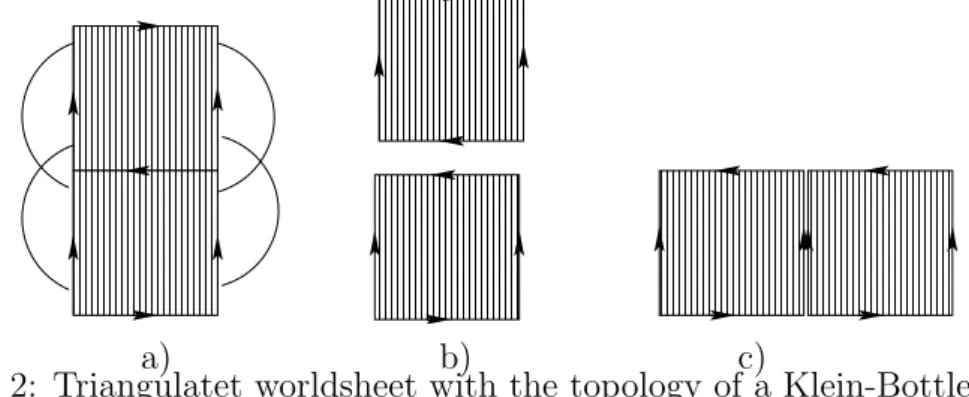Physikalisches Institut Exercise 9
Universit¨ at Bonn 24 May 2015
Theoretische Physik SS 2015
Exercises on Advanced Topics in String Theory
Priv.-Doz. Dr. Stefan F¨ orste
http://www.th.physik.uni-bonn.de/people/forste/exercises/strings15
–Home Exercises– Due to: 01.07.2015
H 9.1 O-plane interactions via RR closed strings and tadpole cancellation (20 points)
Type II string theories have N = 2 supersymmetries. This can be already seen at the level of the massless states, where one finds two dilatinos and 2 gravitinos. These two superparners of the graviton and dilaton belong to the N = 2 supergravity multiplet. One way to construct an N = 1 supersymmetric theory is to introduce unoriented string. To obtain this theory we introduce worldsheet parity Ω. Worlsheet parity is an operator acting on the worldsheet and flips the orientation of the string in the following way
Ω : σ 7→ ` − σ, (1)
where σ parametrises the spatial direction on the worldsheet and ` denotes the string length.
(a) Argue by analysing the spectrum of Type IIA and Type IIB string theory, why world- sheet parity is only a symmetry of Type IIB strings. (2 point s ) (b) How do the parameters x µ 0 and p µ , and the oscillators α µ n , α ˜ µ n , b µ r , ˜ b µ r , d µ n and ˜ d µ n trans- form under Ω. Hint: Consider the string mode expansions and the fact that we want to keep the massless N S N S and RR states. (3 point s ) Due to the presence of the worldsheet parity a spacetime filling O-plane located in the target space. An O-plane is the locus where strings flip their orientation when they hit the O-plane.
We are going to investigate the O-plane interaction via RR strings. RR string states correspond to antisymmetric p-form gauge fields. The O-plane interaction can be thought of a RR closed string with length ` = 2π and Ramond boundary conditions in the left- and right handed sector, moving “away“ from the O-plane, propagating over some time 2πl and touching the O-plane again. The worldsheet of this interaction has the topology of a Klein-Bottle (depicted 2.)
(c) Triangulate the worldsheet of the Klein-Bottle by a rectangle where the crosscap iden- tification is made on the sides parallel to the spatial direction. Then cut the rectangle at σ = π parallel to the timelike direction (figure 2 a)). You obtain two pieces of
1
τ
σ
Figure 1: An O-plane O-plane interaction via RR closed strings.
the worldsheet, one with σ ∈ [0, π) and one with σ ∈ [π, 2π) (figure 2 b)). Now glue the pieces together by identifying one(!) spatial side of the first piece with the corresponding side of the second piece (figure 2 c)). The correspondence is given by the crosscap identification. The side along the timelike (spatial) direction of the manipulated worldsheet has now two times (half of) the length as before. Draw the triangulated worldsheet before and after manipulation and keep track what happens
to the boundary conditions. (2 point s )
a) b) c)
Figure 2: Triangulatet worldsheet with the topology of a Klein-Bottle.
(d) Now perform the following worldsheet duality transformation σ ↔ τ and redefine the coordinates s.t.
σ 0 ∈ [0, 2π), τ 0 ∈ [0, 2πt). (2)
How is the relation between σ and σ 0 (τ and τ 0 )? From now on we will drop the prime for convenience. The relation between l and t is lt = 1 4 . Argue why the new worldsheet corresponds to a loop channel interaction. (2 point s ) (e) We are interested in the RR states at the tree level amplitude. Verify that (−1) F Ω insertion in the supertrace 1 in the loop channel filters these out. Hint: Consider how ψ ± (τ, σ) behaves under τ → 4πt by analysing the triangulated worldsheet. (4 point s ) In summary we obserev that the O-plane O-plane tree level interaction of RR states is identical to the one-loop channel vacuum amplitude given by
Z dt 2t tr
Ω (−1) F
2 e −2πα
0tH
, (3)
1
Remember yourself from QFT that in the definition of the trace a sign is included for the trace over fermions.
2
with
H = p 2 4 + 1
α 0
8
X
i=1
∞
X
n=1
α i −n α i n − 1 24
+ 1
α 0
8
X
i=1
∞
X
r=1/2
rb i −r b i r − 1 48
. (4)
(f) Calculate the trace in (3). The solution should be
∝ 8α 0 π 2 t −5 1 η 12 (e −4πt ) ϑ
0 1/2
4
(e −4πt ). (5)
(5 point s ) (g) Undo the worldsheet duality by expressing t in terms of l and determine the behavior
of the integral in the limit l → ∞. (2 point s )
The limit l → ∞ projects out the O-plane interaction via massless RR strings. Your last result indicates that the theory has tadpoles! To cancell these tadpoles we need to add to the space 32 D-branes in the same homology as the O-plane. Together the cancel the O-plane RR charge and the tadpoles vanish. The stack of branes carry an SO(32) gauge symmetry. Therefore the string theory we constructed has naturally a gauge group (which surprisingly is also a nice candidate for a GUT group 2 :-) ).
2
